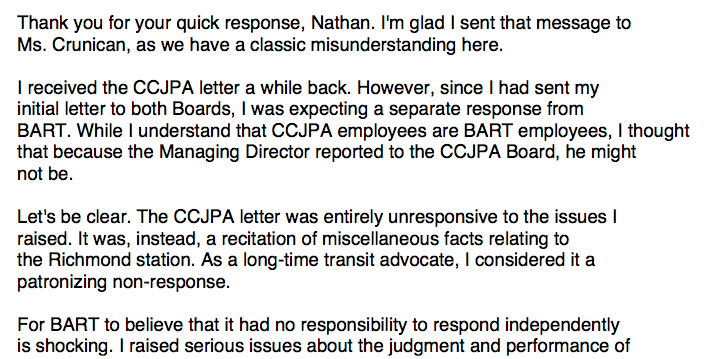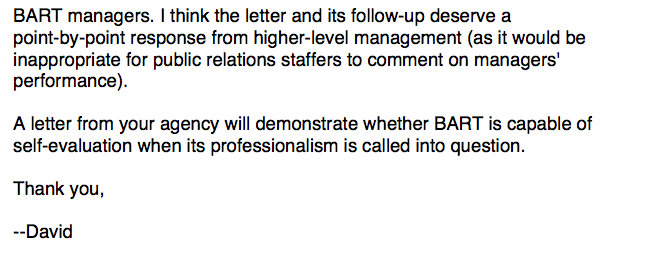The Wall of Shame
When Public
Agencies Ignore the Public
![]()
BART
After the badly
mismanaged closing of the parking for Capitol Corridor and
Amtrak passengers at the Richmond station, TRANSDEF wrote
a the most critical letter
it had ever written,
asking for letters of reprimand for the managers
responsible. The Capitol Corridor Joint Powers Authority
(CCJPA), the body that controls the Capitol Corridor
service, responded with a bland letter that deflected attention away from the
charges made, without actually saying anything in
response.
As CCJPA contracts with BART to operate its service,
CCJPA’s management staff are BART employees. TRANSDEF’s
original letter had been addressed to the Boards of both
the CCJPA and BART. However, BART did not reply. TRANSDEF
then sent this follow-up letter to BART, which included the assertion:
“BART's Amtrak parking program is a perfect demonstration
of much that is wrong with Bay Area transit. It bears the
deep imprint of a staff trained to think in siloes. This
kind of thinking results in disconnections and gaps, which
force the region to develop [the] Seamless Transit
[program] as an antidote.”
After a series of TRANSDEF emails, including the one
immediately below, BART finally responded with this
non-responsive blow-off
letter.


What’s
interesting about the BART Assistant General Manager’s
letter is the absence of any substantive response to
TRANSDEF’s letter and emails, and the implication that
providing information for an individual user’s needs was
somehow an adequate response to the specific policy-based
criticisms expressed by a transit advocacy organization.
This is unthinkable, given the allegation of a violation of
the Title VI anti-discrimination regulations and the
inclusion of a BART director in the email chain.
It is clear that, having sent TRANSDEF these two letters,
CCJPA and BART consider the matter closed and have made it
perfectly clear that they are unwilling to engage in any
kind of self-evaluation--or effort to correct their
shortcomings.
Caltrans and
TAM
The Transportation Authority of Marin
(TAM) and Caltrans were very slow in recognizing and
responding to the trend in the Eastbound backup leading to
the Richmond-San Rafael Bridge, ignoring it for at least
four years, and only then proceeding with a solution that
will finally be open to traffic in 2017. This led to
TRANSDEF proposing in 2015 an Interim Opening of the Third Lane
on the Bridge. Apparently
at Caltrans’ direction, TAM responded with a
non-responsive dismissive
letter, and
then supplemented it with more detailed
non-responsive dismissive
letter.
The most interesting quality of these letters is their
refusal to acknowledge the urgent need to respond to the
congestion created by the agencies’ past failure to act on
the obvious trend of increasing congestion. Instead of
responding to specific elements of the proposal, which by
their nature were intended to be an interim response to crippling congestion, the
letters followed the grand agency tradition of “Announce
& Defend.” The responses defend the project the
agencies are building, rather than address the interim
proposal. Instead of honestly stating that they were
unwilling to consider an interim proposal, the letters
provide a pseudo-response that appears to consider the
individual elements of the proposal. The letters did
not--and could not--provide reasons for not implementing
the individual elements on an interim basis.
Another way of thinking about the responses is that the
agencies remain fixed on their project, and not on the
specific real world problem that they themselves created
through inattention and inaction. Their focus on minimizing
harm to San Quentin Village and East San Rafael entirely
ignores the plight of the thousands of drivers they are
leaving needlessly stuck in traffic. Speaking
psychologically, it would appear that the people in charge
are out of touch with the responsibility they bear for the
actual experience of road users.
Interestingly, one of the main excuses for delay is the
need to conduct environmental review. When asked to explain
why studies were needed to support a categorical exemption
from CEQA review (the whole point of which is to eliminate
the need for studies), MTC obfuscated and refused to
provide an explicit rationale.